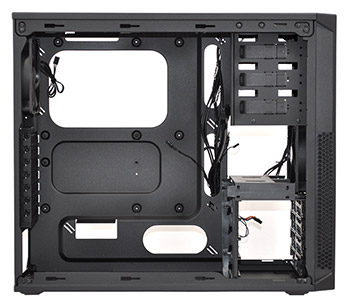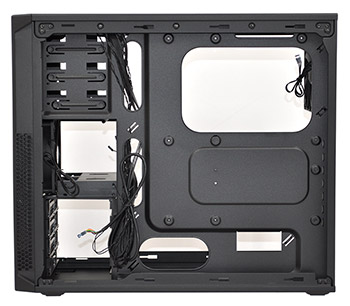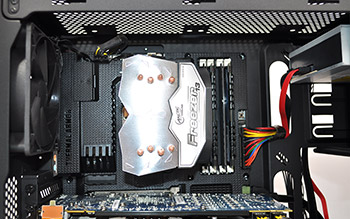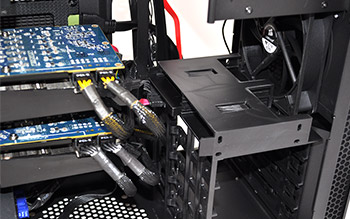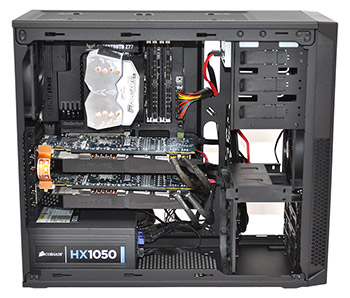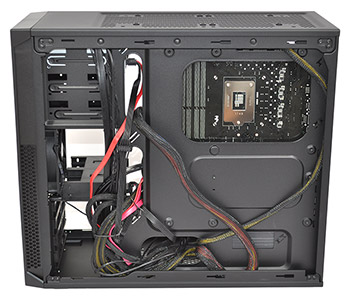Inside the Carbide Series 200R
The Carbide Series 200R has a good habit of looking like a premium product. Continuing where the sleek exterior left off, the all-black innards look good with cable-routing holes in all the right places. Rubber grommets would have been nice, to help hide cables that little bit better, but to Corsair's credit the edges to each hole are well rounded and sharp edges are kept to a minimum.
Straight away, we can see that the one included 120mm front intake has a relatively unobstructed path to the expansion slots, though how much 'clean' air it'll pull from the narrow front vents remains to be seen. A second 120mm front intake can be installed on the outside of the hard-disk cage, but doing so requires removing the chassis' plastic front cover - it comes away by pulling on six plastic clips.
Corsair's task is to improve on existing budget options such as the Antec One, and to the manufacturer's credit, some improvements are immediately visible. The Carbide 200R feels roomier on the inside, with a gap in the storage column and enough room to pass cables up and over the motherboard tray, and all seven expansion slots are equipped with thumb-screwed and reusable brackets. These features make the 200R nice and easy to work with, and ease-of-use is further aided by entirely tool-free storage bays.
You'd be hard pushed to squeeze a radiator into the roof of the chassis, but Corsair has offset the 120mm mounting holes further from the motherboard tray to increase your chances. Putting in a Hydro H100 radiator would be tight, but it might technically be possible using motherboards with a sparse top edge. Bear in mind, also, that the up-and-over cable-routing hole is a bit snug - we had to give the eight-pin CPU power connector a good wiggle to get it through - but it's very handy to have and helps maintain a tidier build.
Our dual Sapphire Radeon HD 7950 graphics cards slot in with room to spare, and we're seeing promise in Corsair's dedicated SSD mounts. Sitting on top of the 3.5in column, the compact 2.5in cage takes up little room yet can house four SSDs with ease. Drives slot in from the left and clip into place (screws can be used, though we don't see any need) but while the system works, there is room for improvement. The unit's plastic material doesn't feel great and the fit is probably a touch too tight - we really had to tug to get our SSD back out, scratching it in the process.
We'd also liked to have seen the 2.5in cage facing forward, making it easy to add/remove drives without fouling multi-GPU configurations. But Corsair's on the right track and it can improve this SSD mounting mechanism for premium chassis. Build it from metal and make it completely modular and it becomes a great tool for SSD-only builds, where it can replace a 3.5in cage entirely.
But not every budget build has solid-state storage, so it's worth noting that the 3.5in and 5.25in bays work just as well. They're tool free, with small, pull-out clips holding drives in place, and though the mounting mechanism is simple, it does the trick.
Here's the Carbide Series 200R equipped with our high-end Intel Z77 test platform. This ATX build includes a high-end 1,050W power supply, an ASUS Sabertooth motherboard, two Sapphire Radeon HD 7950 OC graphics cards in CrossFire and an Arctic Cooling Freezer 13 CPU cooler.
It is, for all intents and purposes, an extreme gaming rig, and the 200R has no problems accommodating all of the components. Better yet, it does so while looking good. There are enough cable-routing holes to keep the clutter hidden out of view (there's adequate room behind the motherboard tray to make sure the back panel fits back on), and the internal cavern doesn't look cramped.
All in all, Corsair's nailed the primary objective; the Carbide Series 200R is really easy to build into. But how well does it cool?






